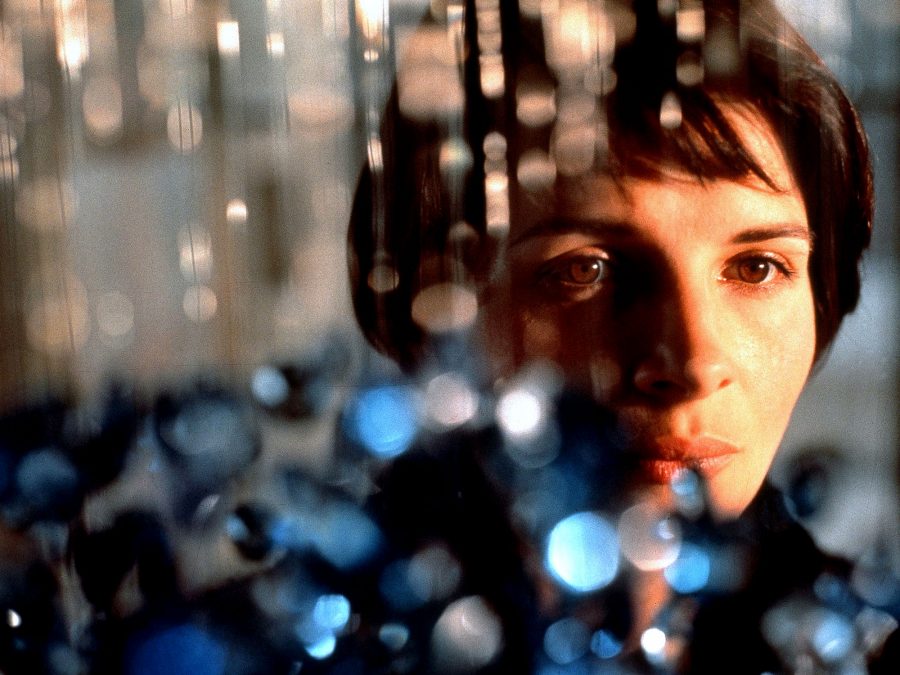One of the most famous shots from Krzysztof Kieślowski’s Three Colours Trilogy is that of a sugar cube absorbing coffee. While it lasts just five seconds, this simple close-up from Three Colours: Blue embodies the experience of space and reality for the protagonist, Julie (Juliette Binoche). More significantly, it acts as a metaphor for the film’s message – this is a film about finding personal liberty in grief, trauma and loss, by observing the relationship between emotional detachment and subjective intimacy.
Three Colours: Blue opens with a car crash that claims the lives of Julie’s husband, a famous composer, and her daughter. The remainder of the film chronicles her subsequent mourning, followed by attempts to rebuild her life. As with much of Kieślowski’s work, the camera focuses on the character’s tactile environment. Textures and characteristics of everyday objects are brought so close into focus that the rest of the world simply fades into the background.
Around 50 minutes in, Julie meets Oliver (Benoît Régent) in a coffee shop, a collaborator of her husband’s who confesses his love for her. In her ambivalence Julie does not react to his advances. Instead, she delicately places a sugar cube in her coffee and waits for the liquid to be absorbed before dropping it. Masterfully shot by Sławomir Idziak, this snapshot of an everyday action may appear insignificant, but on closer inspection it demonstrates how each scene in the film is carefully linked to its core themes.
In Dominique Rabourdin’s documentary Krzysztof Kieślowski: A Lesson in Cinema, Kieślowski himself examines an individual scene from each film in the trilogy. By deconstructing both the technical aspects and the meaning of each scene, he offers a glimpse into his filmmaking style. Of all the scenes in Three Colours: Blue he could have chosen from, Kieślowski zeroes in on these five seconds. This shot, he says, represents how Julie is “trying to contain, to put a lid on her world and immediate environment”. In this fleeting moment in the coffee shop, “only the sugar cube matters, and she intentionally focuses on it to shut out all the things she doesn’t accept”.

In her grief, nothing matters outside of this enclosed space. Not the other customer or the man who has just opened his heart to her. By dislocating Julie from her surroundings and focusing on a moment of self-reflection, Kieślowski draws the viewer into a point-of-view perspective. The use of shallow focus, forming a silhouette around the coffee cup, signifies her protective shield against the loss that has engulfed her, and as the sugar cube slowly changes colour Julie’s emotional battle becomes clear; she must relearn how to interact with the world around her again.
Kieślowski knew that this shot had to be exactly five seconds. Any less and it wouldn’t allow us to reflect on the protagonist’s situation. Any longer and it wouldn’t hold our attention. In order to find the right balance, the director asked his production assistant to test all different kinds of sugar cube in order to find one that would soak up the coffee in precisely five seconds. Why go to all this trouble for such a brief amount of screen time?
In his own words, Kieślowski wanted to show that “everybody’s life is worthy of scrutiny, has its secrets and dramas”. To convey Julie’s personal reaction to loss, the camera must render her at a distance from reality. Kieślowski believes this is how screen and viewer can interact. A simple five-second shot, designed and constructed with the viewer in mind, demonstrates how we can be drawn into a character’s milieu, and how even the smallest detail can profoundly impact our viewing experience.
The post In praise of Krzysztof Kieslowski’s sugar cube appeared first on Little White Lies.
![Forest Essentials [CPV] WW](https://s3-us-west-2.amazonaws.com/pcw-uploads/logos/forest-essentials-promo-codes-coupons.png)
0 comments